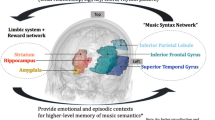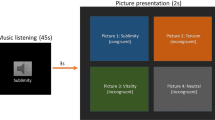Abstract
Difficulties in source monitoring (SM) tasks observed in healthy older adults may be linked to associative memory deficits since SM requires individuals to correctly bind and later remember these bound features to discriminate the origin of a memory. Therefore, focusing attention on discriminating factors that may attenuate older adults’ difficulties in attributing contextual information to memories is necessary. We investigated the effect of affective information on source monitoring in younger and older adults by manipulating the type of affective information (pictures and music) and assessing the ability to remember spatial and temporal source details for affective pictures encoded while listening to classical music. Older and younger adults viewed a series of affective IAPS pictures presented on the left or right side of the computer screen in two different lists. At test, participants were asked to remember if the picture was seen (right/left), in which list (list1/list2) or whether it was new. Results showed that spatial information was attributed better than temporal information and emotional pictures were attributed better than neutral pictures in both younger and older adults. In addition, although music significantly increased source memory performance in both younger and older participants compared to the white noise condition, the pleasantness of music differentially affected memory for source details. The authors discuss findings in terms of an interaction between music, emotion and cognition in aging.

Similar content being viewed by others
References
Bopp KL, Verhaeghen P (2007) Age-related differences in control processes in verbal and visuospatial working memory: storage, transformation, supervision, and coordination. J Gerontol B Psychol Sci Soc Sci 62:P239–P246
Peters E, Dieckmann NF, Weller J (2011) Chap. 9—age differences in complex decision making. In: Handbook of the psychology of aging (Seventh Edition). Academic Press, San Diego, pp 133–151
Mitchell KJ, Johnson MK (2009) Source monitoring 15 years later: what have we learned from fMRI about the neural mechanisms of source memory? Psychol Bull 135:638–677. https://doi.org/10.1037/a0015849
Bayen UJ, Murnane K, Erdfelder E (1996) Source discrimination, item detection, and multinomial models of source monitoring. J Exp Psychol Learn Mem Cogn 22:197–215
Altamura M, Padalino FA, Stella E et al (2016) Facial emotion recognition in bipolar disorder and healthy aging. J Nerv Ment Dis 204:188–193. https://doi.org/10.1097/NMD.0000000000000453
Fairfield B, Mammarella N, Di Domenico A et al (2015) Running with emotion: when affective content hampers working memory performance. Int J Psychol J Int Psychol 50:161–164. https://doi.org/10.1002/ijop.12101
Di Domenico A, Palumbo R, Mammarella N et al (2015) Aging and emotional expressions: is there a positivity bias during dynamic emotion recognition? Front Psychol 6:1130. https://doi.org/10.3389/fpsyg.2015.01130
Di Domenico A, Palumbo R, Fairfield B et al (2016) Fighting apathy in Alzheimer’s dementia: a brief emotional-based intervention. Psychiatry Res 242:331–335. https://doi.org/10.1016/j.psychres.2016.06.009
Mammarella N, Fairfield B, Di Domenico A (2012) Comparing different types of source memory attributes in dementia of Alzheimer’s type. Int Psychogeriatr 24:666–673. https://doi.org/10.1017/S1041610211002274
Zebrowitz LA, Franklin RG, Palumbo R (2015) Ailing voters advance attractive congressional candidates. Evol Psychol Int J Evol Approaches Psychol Behav 13:16–28
Mammarella N, Di Domenico A, Palumbo R et al (2016) Self-generation and positivity effects following transcranial random noise stimulation in medial prefrontal cortex: a reality monitoring task in older adults. Cortex J Devoted Study Nerv Syst Behav. https://doi.org/10.1016/j.cortex.2016.11.005
Fairfield B, Mammarella N, Di Domenico A (2013) Centenarians holy memory: is being positive enough? J Genet Psychol 174:42–50. https://doi.org/10.1080/00221325.2011.636399
Mather M, Carstensen LL (2005) Aging and motivated cognition: the positivity effect in attention and memory. Trends Cogn Sci 9:496–502. https://doi.org/10.1016/j.tics.2005.08.005
Kensinger EA, Schacter DL (2008) Neural processes supporting young and older adults’ emotional memories. J Cogn Neurosci 20:1161–1173. https://doi.org/10.1162/jocn.2008.20080
Palumbo R, D’Ascenzo S, Quercia A et al (2017) Adaptation to complex pictures: exposure to emotional valence induces assimilative aftereffects. Front Psychol. https://doi.org/10.3389/fpsyg.2017.00054
Schellenberg EG (2005) Music and Cognitive Abilities. Curr Dir Psychol Sci 14:317–320. https://doi.org/10.1111/j.0963-7214.2005.00389.x
Stalinski SM, Schellenberg EG (2013) Listeners remember music they like. J Exp Psychol Learn Mem Cogn 39:700–716. https://doi.org/10.1037/a0029671
Swaminathan S, Schellenberg EG (2015) Current emotion research in music psychology. Emot Rev 7:189–197. https://doi.org/10.1177/1754073914558282
Kämpfe J, Sedlmeier P, Renkewitz F (2011) The impact of background music on adult listeners: a meta-analysis. Psychol Music 39:424–448. https://doi.org/10.1177/0305735610376261
Mammarella N, Fairfield B, Cornoldi C (2007) Does music enhance cognitive performance in healthy older adults? The Vivaldi effect. Aging Clin Exp Res 19:394–399
Fox LS, Knight BG, Zelinski EM (1998) Mood induction with older adults: a tool for investigating effects of depressed mood. Psychol Aging 13:519–523
Knight BG, Maines ML, Robinson GS (2002) The effects of sad mood on memory in older adults: a test of the mood congruence effect. Psychol Aging 17:653–661
Ferraro FR, King B, Ronning B et al (2003) Effects of induced emotional state on lexical processing in younger and older adults. J Psychol 137:262–272. https://doi.org/10.1080/00223980309600613
Fairfield B, Mammarella N, Di Domenico A (2015) Motivated goal pursuit and working memory: are there age-related differences? Motiv Emot 39:201–215. https://doi.org/10.1007/s11031-014-9428-z
Bower GH (1981) Mood and memory. Am Psychol 36:129–148
Mammarella N, Di Domenico A, Palumbo R et al (2016) When green is positive and red is negative: aging and the influence of color on emotional memories. Psychol Aging 31:914–926. https://doi.org/10.1037/pag0000122
Batchelder WH, Riefer DM (1999) Theoretical and empirical review of multinomial process tree modeling. Psychon Bull Rev 6:57–86
Riefer DM, Hu X, Batchelder WH (1994) Response strategies in source monitoring. J Exp Psychol Learn Mem Cogn 20:680–693
Mammarella N, Di Domenico A, Palumbo R et al (2016) Noradrenergic modulation of emotional memory in aging. Ageing Res Rev 27:61–66. https://doi.org/10.1016/j.arr.2016.03.004
Fairfield B, Mammarella N, Palumbo R et al (2015) Emotional meta-memories: a review. Brain Sci 509–520. https://doi.org/10.3390/brainsci5040509
Palumbo R, Fairfield B, Mammarella N et al (2017) Does make-up make you feel smarter? The “lipstick effect” extended to academic achievement. Cogent Psychol. https://doi.org/10.1080/23311908.2017.1327635
Borella E, Carretti B, Grassi M et al (2014) Are age-related differences between young and older adults in an affective working memory test sensitive to the music effects? Front Aging Neurosci 6:298. https://doi.org/10.3389/fnagi.2014.00298
Niedenthal PM, Setterlund MB (1994) Emotion congruence in perception. Pers Soc Psychol Bull 20:401–411. https://doi.org/10.1177/0146167294204007
Storbeck J, Clore GL (2005) With sadness comes accuracy; with happiness, false memory: mood and the false memory effect. Psychol Sci 16:785–791. https://doi.org/10.1111/j.1467-9280.2005.01615.x
Riener CR, Stefanucci JK, Proffitt DR et al (2011) An effect of mood on the perception of geographical slant. Cogn Emot 25:174–182. https://doi.org/10.1080/02699931003738026
May CP, Rahhal T, Berry EM et al (2005) Aging, source memory, and emotion. Psychol Aging 20:571–578. https://doi.org/10.1037/0882-7974.20.4.571
Schellenberg EG, Hallam S (2005) Music listening and cognitive abilities in 10- and 11-year-olds: the blur effect. Ann N Y Acad Sci 1060:202–209. https://doi.org/10.1196/annals.1360.013
Storbeck J, Watson P (2014) Verbal makes it positive, spatial makes it negative: working memory biases judgments, attention, and moods. Emot Wash DC 14:1072–1086. https://doi.org/10.1037/a0037327
Gray JR (2004) Integration of emotion and cognitive control. Curr Dir Psychol Sci 13:46–48. https://doi.org/10.1111/j.0963-7214.2004.00272.x
Author information
Authors and Affiliations
Contributions
NM and BF conceived and designed the experiments; RP and BF performed the experiments; RP and ADD analyzed the data; RP and BF contributed materials/analysis tools; NM, BF, and RP wrote the paper.
Corresponding author
Ethics declarations
Conflict of interest
The authors declare that they have no conflict of interest.
Ethical approval
All procedures performed in this study which involved human participants were in accordance with the Declaration of Helsinki, and the protocol was approved by the institutional review boards at University of Chieti.
Informed consent
All participants gave their informed consent for inclusion before they participated in the study.
Rights and permissions
About this article
Cite this article
Palumbo, R., Mammarella, N., Di Domenico, A. et al. When and where in aging: the role of music on source monitoring. Aging Clin Exp Res 30, 669–676 (2018). https://doi.org/10.1007/s40520-018-0955-4
Received:
Accepted:
Published:
Issue Date:
DOI: https://doi.org/10.1007/s40520-018-0955-4




